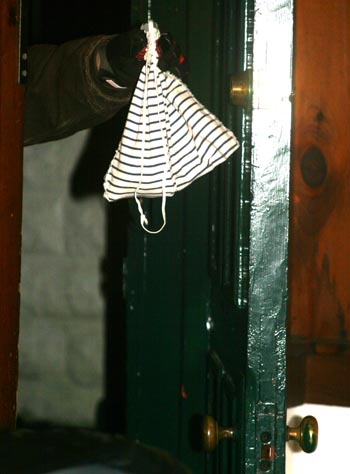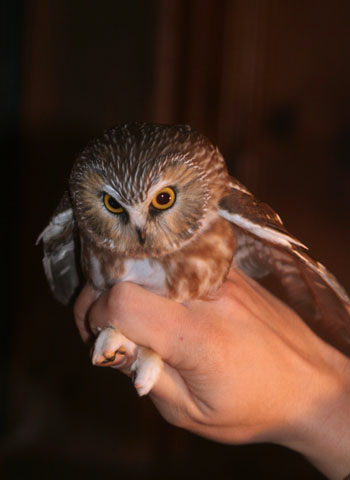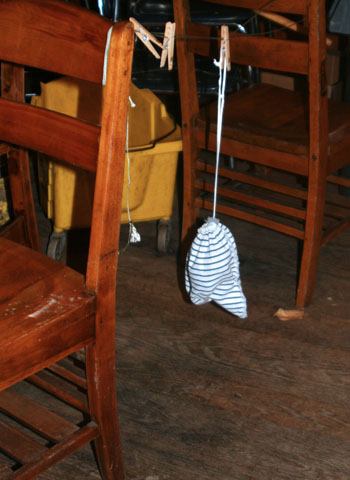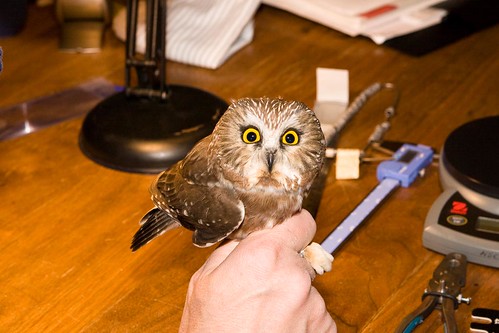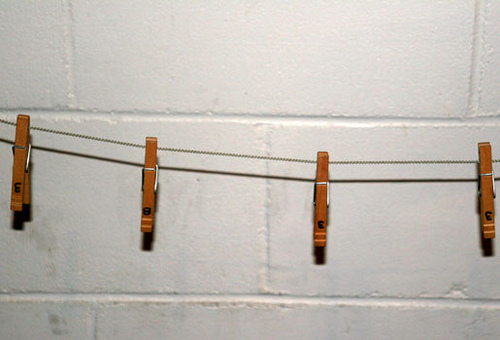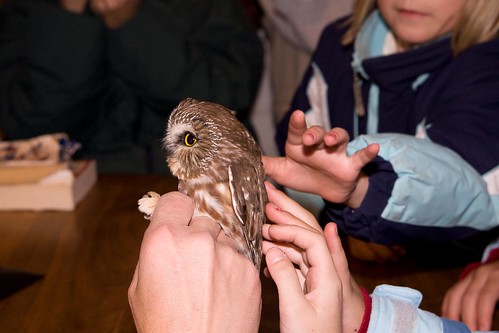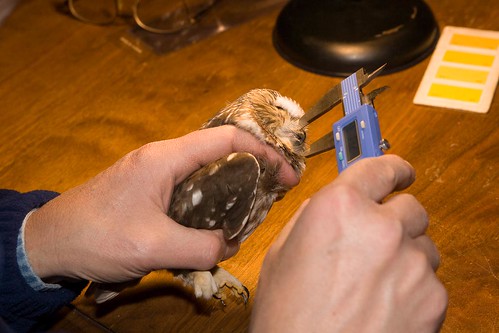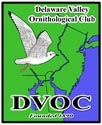Last Owl in is a Winner
What weighs 88.4 grams and comes in a drawstring bag?
Here’s another bunch of clues. It has yellow eyes, a 10.3 mm bill length, and sometimes you can find it in a mist net at night. Sometimes it can be adopted.
Exactly.
A Northern Saw-whet Owl.
If you read my post “Waiting for Godot’s Owls” you will recall the long evening I and other Delaware Valley Ornithology Club members spent anticipating the capture of a saw-whet or two, but that ended without a single owl appearance.
But, apparently, waiting around for owls can be addicting. After 5-6 hours hanging out with DVOC members on that first outing to the Hidden Valley banding station I was chilled, drowsy and ready for bed, but begging to come back the next week to sit and wait for those elusive owls.
The 2008 season was a low one for Saw-whet Owl captures along the Kittatiny Range. Barely over 200 individuals had been caught between the 3 banding stations; Hidden Valley, King’s Gap, and Small’s Valley. Compare that to the 900 owls that might be banded in good years.
When there had been zero capture during my second visit to Hidden Valley I had begun to accept that this was not going to be an owl-year for me. However, I figured that, owl or no owl, my third and last visit would still offer one more pleasant evening of conversation with the project volunteers on duty and another chance just to savor that essence of being in a forest at night.
I stepped from my car, greeted by the audiolure’s call of a male Saw-whet Owl that echoed through the darkness, and the crack of yellow light that spilled from the cabin door as Nate (bander and researcher) welcomed me inside for another owl vigil.
We sat with our feet next to the heater under the banding table, and within a comfortable reach there was a plentiful offering of snacks, including hotdogs and saurkraut. The evening was as mellow as previous ones until the door opened and an outstretched arm thrust a drawstring bag into the room.
It was Nate’s arm. He had just come back from checking the mist nets but apparently was just standing outside holding this owl-bag through the door like it was supposed to signify something. Maybe the hotdogs and saurkraut had put up roadblocks along the neuron pathways in my brain because the understanding of what the drawstring bag meant did not take the most direct route from one neuron to the next. But when it finally got to the target neuron, I felt a joyful surprise as if someone had handed me a gift and I’d forgotten it was my birthday.
An owl had arrived. The first and only owl of the night, and a winner. The last owl of the 2008 season, bringing the total number of saw-whet owls banded by all three stations to 219.
And it was my owl in another way, too. On my first visit to Hidden Valley I got the adopt-an-owl bug and had signed up to be a proud parent of a saw-whet owl. The fee for the adoption goes to help fund the Northern Saw-whet Owl Project, which is sponsored by the Ned Smith Center for Nature and the Art. In return I get a certificate with a photo of me and my owl. Moreover, I will be notified of any future sightings or captures of my owl along with any accompanying data; was she seen as far north as Ontario? Was she eating an insect, a vole, a warbler? Did she have a nest with young? Did she look healthy?
Owl adoptions also make great Xmas or birthday gifts, should you be considering something for a friend of relative. My sister-in-law and a couple of my friends will confirm this. Click here to get started on that gift list now.
Often the adoptive parent will be assigned an owl from any of the 3 banding stations maintained by Scott Weidensaul, but if you should happen to be present during the capture of an owl, you may request that owl as yours.
Cute to the extreme, a true pocket pet, this owl was a bonafide Precious Planet Critter if ever there was one. The owl was a ’she’, and I gave her the name of Chipeta.
There was a lot of personal data to be gathered before Chipeta was to be released back into the woods. Nate took measurements of her tail and bill, and recorded the length of her wing when flat, as well as that of her folded wing (wing chord). He noted the thickness of adipose tissue on her body and whether or not her crop had remains of a meal in it.
Some necessities for banding saw-whets.
The wing chord length and the weight are the two determining factors that establish a saw-whet’s sex when there isn’t enough weight discrepancy between the males (75 grams) and the females (100 grams).
Weighing slightly more than a shot glass full of vodka, Chipeta’s 88.4 grams was on the light side for a female, and it fell into the overlap of male/female weights. Therefore, both her wing chord length and her weight were correlated onto a Sex Ratio Chart and that told us she could be Chipeta and not Chip.
Measuring the wing chord length.
Owls are the only birds that have the pigment porphyrin in their wing feathers. Porphyrin decreases as owls get older and it shows up well under flourescent light. The varying amounts of porphyrin seen in under a UV lamp help researchers read the molt pattern in the wing feathers and thus, estimate an owl’s age. For an excellent shot of what the molt patterns look like under flourescent light click here.
Chipeta was found to be in her second year.
There are some physical traits, such as eye color, that vary among the saw-whet owls. Presently, no one knows what significance these characterstics may have but they are included in the overall data gathering. Eye color in saw-whets has come in the four shades of yellow seen on the eye color chart below. Chipeta’s eye color best matched the soft moonlight yellow (number 4) at the bottom of the chart.
We also noted down the white on the tip of her beak.
And of course, most importantly Chipeta is fitted for her band.
Chipeta takes a size 4 band.
Saw-whet owls tend to be calm while being handled and Chipeta was no different. During the whole exam and banding session she remained collected and stared back at us with as much curiosity as we did at her. But all too soon it was time for her to go, and hard as it was to resist slipping her “accidentally” into my coat pocket, our little friend was placed gently back into her drawstring bag. The bag was left suspended in an adjacent dark room so that her eyes could re-adjust to the darkness. Then after some 25 minutes Chipeta was released outside where she flew back into the dark and onto the rest of her life.
It is possible that I may never hear any news of Chipeta down the road, but as more and more owls are recovered over the years as the Northen Saw-whet Owl Project continues, the odds increase in my favor. My biggest hope is to hear some news in another 7 years or so, when Chipeta will be a ripe age of 9 and has lived a full life in saw-whet years.
They say that good things come in small drawstring bags. Well, it’s true.
If you are interested in booking a visit to any of the banding stations please click here.
Should you ever find a banded bird, please call 1-800-327-BAND.

